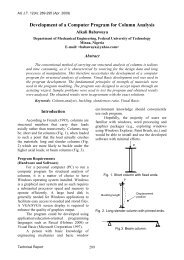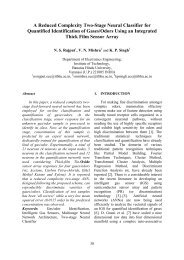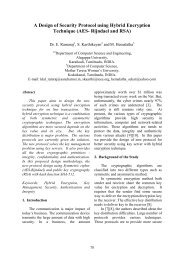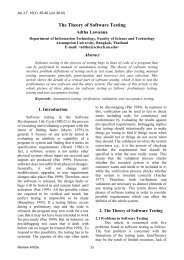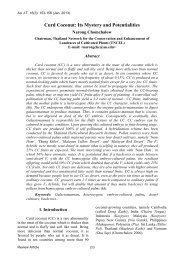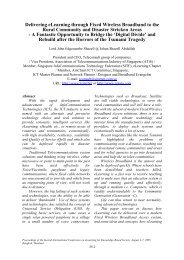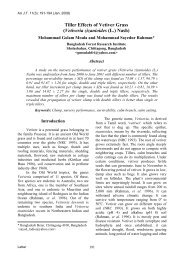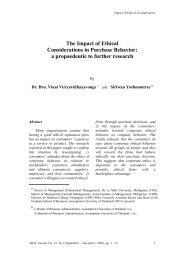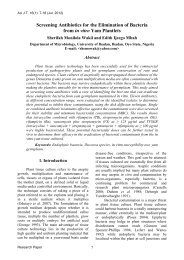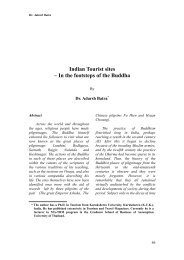Production of Tannin from the Bark of Eucalyptus ... - AU Journal
Production of Tannin from the Bark of Eucalyptus ... - AU Journal
Production of Tannin from the Bark of Eucalyptus ... - AU Journal
Create successful ePaper yourself
Turn your PDF publications into a flip-book with our unique Google optimized e-Paper software.
and sugar. Gallotannin, <strong>the</strong> best-known<br />
hydrolyzable tannin, is extracted by treating<br />
Turkish or Chinese nutgall with water or organic<br />
solvents.<br />
<strong>Tannin</strong>s have diverse uses (Austin 1994).<br />
The traditional use is for rendering raw hides into<br />
lea<strong>the</strong>r. But <strong>the</strong>y have also been employed<br />
industrially in denaturing alcohol; in aqueous<br />
solution for treating burns and protecting plant<br />
against dehydration and damage by animals; as<br />
mordants on dyeing; as antidote for metallic,<br />
alkaloid and glycoside poisons; and as reagents in<br />
photography. They are also added to mud in oil<br />
drilling operation to increase <strong>the</strong> viscosity and have<br />
been used for <strong>the</strong> manufacture <strong>of</strong> ink, rubber and<br />
plastics; for preventing sculling in hot waters; for<br />
ores flotation and water treatment; and by<br />
combining <strong>the</strong>m with binding agents such as<br />
polyvinyl pyrrolidone (PVP) to clarify wine and<br />
beer.<br />
Due to <strong>the</strong> dangers posed by <strong>the</strong><br />
environment <strong>from</strong> wastes in various forms, <strong>the</strong>re<br />
has been a new research focus in <strong>the</strong> effective<br />
utilization <strong>of</strong> chemical and agricultural by-products<br />
that have hi<strong>the</strong>rto been regarded as wastes. It is<br />
also a step in <strong>the</strong> right direction <strong>of</strong> a new initiative<br />
called “ZERI option” which discusses <strong>the</strong> use <strong>of</strong><br />
waste or pollutants <strong>from</strong> one system as raw<br />
materials in ano<strong>the</strong>r system (Agho 1999). The<br />
bark <strong>of</strong> EC normally peels <strong>of</strong>f during <strong>the</strong> dry<br />
season and litter <strong>the</strong> plantation, serving as ready<br />
substrate for pathogens.<br />
The objective <strong>of</strong> this work is to explore <strong>the</strong><br />
possibility <strong>of</strong> a commercial production <strong>of</strong> tannin<br />
<strong>from</strong> <strong>the</strong> bark <strong>of</strong> EC.<br />
Experimental Work<br />
The bark <strong>of</strong> EC was dried, ground and<br />
classified into different sizes using a sieve shaker.<br />
An amount <strong>of</strong> 0.5 kg <strong>of</strong> <strong>the</strong> ground bark was taken<br />
<strong>from</strong> each size range and put in a beaker. Tap or<br />
distilled water was added and <strong>the</strong> mixture agitated<br />
or soaked for a period <strong>of</strong> time. The resulting<br />
solution was filtered and tannin was recovered as<br />
flakes <strong>from</strong> <strong>the</strong> filtrate by distilling <strong>of</strong>f <strong>the</strong> solvent or<br />
evaporating it in an open beaker. The temperature<br />
<strong>of</strong> <strong>the</strong> heating medium was adjusted when <strong>the</strong><br />
tannin started forming as flakes. The tannin<br />
content <strong>of</strong> <strong>the</strong> extracts was compared by using a<br />
colorimeter to measure <strong>the</strong> absorption factor (at<br />
wavelength <strong>of</strong> 540 nm) <strong>of</strong> a prepared solution <strong>of</strong><br />
<strong>the</strong> extract to which ferric chloride was added.<br />
Table 1 gives <strong>the</strong> experimental data for <strong>the</strong><br />
operating variables. It shows that <strong>the</strong> variables<br />
investigated were particle size distribution, leaching<br />
time, type <strong>of</strong> solvent, method <strong>of</strong> leaching and<br />
method <strong>of</strong> solvent removal.<br />
Results and Discussion<br />
Tables 2 to 4 show <strong>the</strong> yield and yield<br />
percent for <strong>the</strong> different experimental runs. The<br />
yields for smaller-sized samples were greater than<br />
those <strong>of</strong> larger-sized samples. This is in<br />
consonance with mass transfer <strong>the</strong>ory because <strong>the</strong><br />
former present higher interfacial area between <strong>the</strong><br />
solvent and solute. The solution <strong>of</strong> tannin<br />
produced has pH <strong>of</strong> 6.0. It is <strong>the</strong>refore acidic as<br />
expected.<br />
Table 2 and 3 were obtained using <strong>the</strong> same<br />
operating parameters, except for <strong>the</strong> leaching<br />
solvent. Tap water was used for <strong>the</strong> set <strong>of</strong><br />
experiments in Table 2 while distilled water used<br />
for that in Table 3. From Fig.1, it can be clearly<br />
seen that <strong>the</strong> yields obtained for 1 hr were bigger<br />
in Table 2 than in Table 3. The same holds for<br />
o<strong>the</strong>r leaching times. The absorption factors <strong>of</strong> <strong>the</strong><br />
extracts in EXPTA were higher than those <strong>of</strong><br />
EXPTB. A typical value <strong>of</strong> <strong>the</strong> absorption factors<br />
is shown in Table 6. Since tap water was used in<br />
EXPTA, this implies that tannin may have<br />
contained higher impurities that <strong>the</strong> tannin <strong>of</strong><br />
EXPTB. However, when <strong>the</strong> statistical<br />
comparison <strong>of</strong> <strong>the</strong> results for EXPTA and EXPTB<br />
(typified by EXPTA1 and EXPTB1) is done as in<br />
Table 7, it could be seen that <strong>the</strong> difference in yield<br />
is not appreciable because <strong>the</strong> correlation<br />
coefficient is close to 1.0.<br />
Fig. 2 compares <strong>the</strong> yield <strong>of</strong> EXPTA for 3<br />
hours with that <strong>of</strong> EXPTC for 6 hrs. It was



